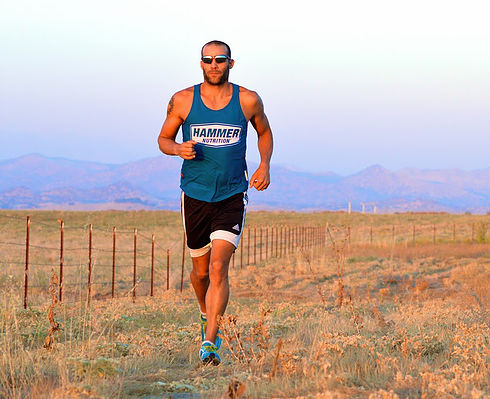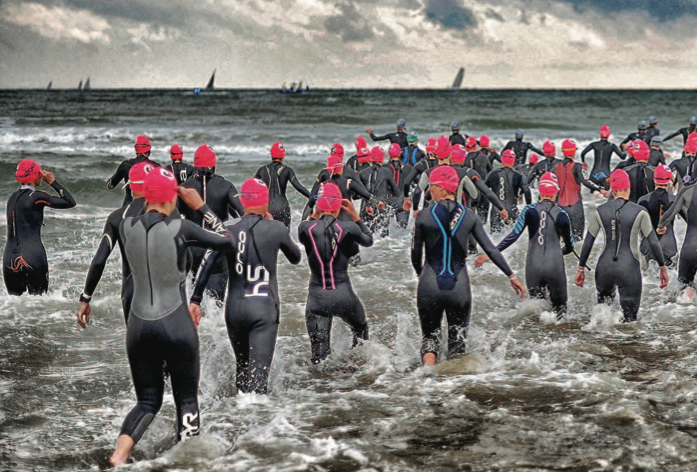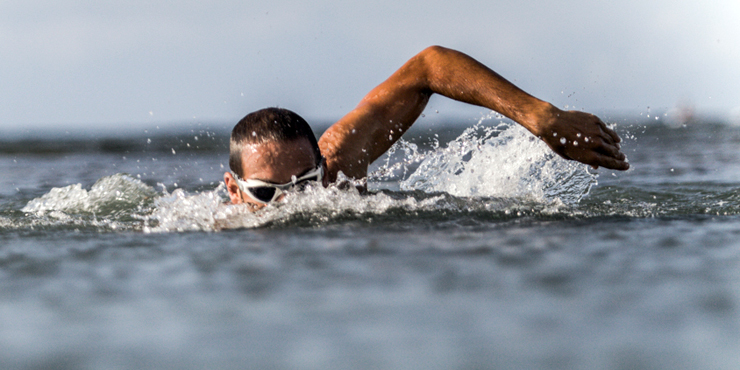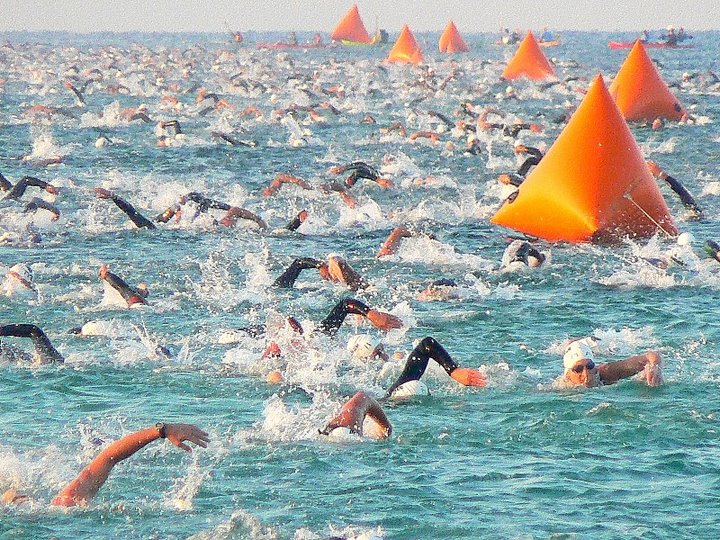Written by David Tatum, USAT Level 1 coach and IRONMAN All World Athlete
Swimming in triathlon happens to be an area in which you can actually make the course longer than it really is. Most people do the majority of their swim training for triathlon in a pool and they are used to having a visual marker at the bottom of the pool to follow during their entire swim. Come race day, the majority of triathlons are done in open water with little to no visibility. With the loss of visibility, it’s no wonder many swimmers have a hard time swimming in a straight line. Even the best swimmers may end up off course to some degree if they simply swam by feel and didn’t sight occasionally. Here are eight tips on how to improve your swim by traveling the shortest distance in the water from point A to point B.
1. Pick a visual object that is larger than the buoy itself
For many swims there are visual references in the distance that are much bigger than the buoys themselves. These visual references can be much easier to sight. If you can, choose a building, a tree, a lighthouse, or any other object that is lined up with the buoy as a visual guide. Be careful not to use a moving object such as a boat or a lifeguard on a paddleboard. Pick a stationary object that will be easy to see and remember.
2. Use side references if possible
There are some races like IRONMAN Vineman 70.3 that are done in a river. The swim is simply an out and back course design. For a race like this, you can really limit your forward sighting by simply using the side of the river as a guide every time you breathe. When you take a breath just look and make sure the distance from you to the shore is remaining the same. On occasion, look forward to remind yourself how close or far you are away from the turn.
3. Visualization
Visualizing can be a powerful tool that will help in this area of the race. Use you minds eye to visualize a straight line in front of you and follow that line. Every time you look up, visualize a line straight to the buoy and try to think of swimming along that line. As you swim, you might find that you tend to turn one direction or the other naturally. Try to counter balance that tendency by adjusting where you are visualizing that line.
4. Site for the turn buoy, not the ones in-between
Many people make the mistake of sighting the reference buoys between themselves and the next turn buoy. Reference buoys are sometimes different colors (yellow) and the turn buoys will usually be red. There are buoys in-between to give you a visual reference of distance and help guide you, but they are not always lined up straight. If you can see the last buoy in line, always use that as your guide.
5. Goggles
This should go without saying, but make sure you have a good pair of goggles that are not going to fog up on you. There are several defog products out there to help with this problem. Also, think about where the sun will be in the morning. The best way to get an idea is to swim the course the day before at the same time as race start. Decide then, if you will need tinted goggles or not.
6. Sighting
Depending on how straight of a swimmer you are, you may need to sight more or less in an open water swim. To site properly, breathe on the first stroke and then lift your head on the next stroke. Lift your head straight up just enough for your eyes to break the plane of the water and get a picture in your head of where you are. After you have a good mental picture, relax your neck again and face down. Because you will be doing this a lot, make sure to use some Body Glide on the back of your neck to avoid a painful rash from your wetsuit.
7. Follow the feet in front of you
If all else fails and you are not comfortable sighting while you swim, you can always follow another swimmer’s feet in front of you. Drafting can save both time and energy, but you are relying on the sighting ability of that swimmer…which may or may not be a good idea.
8. Practice
Don’t wait until race day to build your sighting muscles! This is a huge mistake many beginning triathletes make. They get out of the water race day and don’t understand why their neck hurts. Take the time a few weeks leading up to the race to start sighting in the pool during training. To do this, simply take a breath and then sight on the next stroke once every 25 yards. Try sighting every time you get half way across the pool. This will help you develop the technique and build the needed muscles for race day.
 About the Author: David Tatum USAT Level 1 coach and IRONMAN All World Athlete. David has over ten years of experience as a swim and lifeguard instructor, and coach. As a coach, David has a passion to see athletes succeed and grow in their abilities. To learn more about David Tatum and his coaching, visit www.tricoachtatum.com.
About the Author: David Tatum USAT Level 1 coach and IRONMAN All World Athlete. David has over ten years of experience as a swim and lifeguard instructor, and coach. As a coach, David has a passion to see athletes succeed and grow in their abilities. To learn more about David Tatum and his coaching, visit www.tricoachtatum.com.



